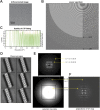Correction: Structural basis for the prion-like MAVS filaments in antiviral innate immunity
- PMID: 26314863
- PMCID: PMC4526786
- DOI: 10.7554/eLife.07546
Correction: Structural basis for the prion-like MAVS filaments in antiviral innate immunity
Keywords: MAVS; biophysics; cryoEM reconstruction; human; immunology; innate immunity; prion-like filaments; structural biology; viruses.
Conflict of interest statement
ZJC: Reviewing editor,
The other authors declare that no competing interests exist.
Figures



Erratum for
-
Structural basis for the prion-like MAVS filaments in antiviral innate immunity.Elife. 2014 Jan 1;3:e01489. doi: 10.7554/eLife.01489. Elife. 2014. PMID: 24569476 Free PMC article.
Similar articles
-
Author Correction: WDR77 inhibits prion-like aggregation of MAVS to limit antiviral innate immune response.Nat Commun. 2023 Sep 25;14(1):5960. doi: 10.1038/s41467-023-41712-w. Nat Commun. 2023. PMID: 37749076 Free PMC article. No abstract available.
-
The specific and essential role of MAVS in antiviral innate immune responses.Immunity. 2006 May;24(5):633-42. doi: 10.1016/j.immuni.2006.04.004. Immunity. 2006. PMID: 16713980
-
MAVS-mediated host cell defense is inhibited by Borna disease virus.Int J Biochem Cell Biol. 2013 Aug;45(8):1546-55. doi: 10.1016/j.biocel.2013.05.012. Epub 2013 May 20. Int J Biochem Cell Biol. 2013. PMID: 23702035
-
Innate and intrinsic antiviral immunity in skin.J Dermatol Sci. 2014 Sep;75(3):159-66. doi: 10.1016/j.jdermsci.2014.05.004. Epub 2014 Jun 2. J Dermatol Sci. 2014. PMID: 24928148 Review.
-
Structural basis of innate immune recognition of viral RNA.Cell Microbiol. 2013 Mar;15(3):386-94. doi: 10.1111/cmi.12061. Epub 2012 Nov 21. Cell Microbiol. 2013. PMID: 23110455 Review.
Cited by
-
Mitochondria as intracellular signaling platforms in health and disease.J Cell Biol. 2020 May 4;219(5):e202002179. doi: 10.1083/jcb.202002179. J Cell Biol. 2020. PMID: 32320464 Free PMC article. Review.
-
MAVS activates TBK1 and IKKε through TRAFs in NEMO dependent and independent manner.PLoS Pathog. 2017 Nov 10;13(11):e1006720. doi: 10.1371/journal.ppat.1006720. eCollection 2017 Nov. PLoS Pathog. 2017. PMID: 29125880 Free PMC article.
-
Helical reconstruction in RELION.J Struct Biol. 2017 Jun;198(3):163-176. doi: 10.1016/j.jsb.2017.02.003. Epub 2017 Feb 11. J Struct Biol. 2017. PMID: 28193500 Free PMC article.
-
Helical Indexing in Real Space.Sci Rep. 2022 May 17;12(1):8162. doi: 10.1038/s41598-022-11382-7. Sci Rep. 2022. PMID: 35581231 Free PMC article.
-
RNA-binding proteins hnRNPM and ELAVL1 promote type-I interferon induction downstream of the nucleic acid sensors cGAS and RIG-I.EMBO J. 2025 Feb;44(3):824-853. doi: 10.1038/s44318-024-00331-x. Epub 2024 Dec 20. EMBO J. 2025. PMID: 39707025 Free PMC article.
References
Publication types
LinkOut - more resources
Full Text Sources
Miscellaneous

